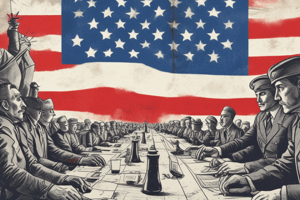Podcast
Questions and Answers
Who introduced the Containment Policy in 1947?
Who introduced the Containment Policy in 1947?
- Joseph Stalin
- Harry S. Truman
- George Kennan (correct)
- Franklin D. Roosevelt
What was the main goal of the Containment Policy?
What was the main goal of the Containment Policy?
- To reduce military spending
- To promote democracy globally
- To prevent the spread of communism (correct)
- To establish the United States as a global hegemon
What characterized proxy wars during the Cold War?
What characterized proxy wars during the Cold War?
- Indirect involvement through surrogate forces (correct)
- Direct involvement of the US and Soviet Union
- Were only fought in Europe
- Only involved the US and Soviet Union
What was the main feature of the nuclear deterrence strategy?
What was the main feature of the nuclear deterrence strategy?
What was the name of the doctrine that threatened nuclear response to a conventional attack?
What was the name of the doctrine that threatened nuclear response to a conventional attack?
What was the purpose of the SALT I and START I agreements?
What was the purpose of the SALT I and START I agreements?
What was the name of the US-backed movement in the Afghan War?
What was the name of the US-backed movement in the Afghan War?
What was the name of the civil war in Africa where the US and Soviet Union provided support to opposing sides?
What was the name of the civil war in Africa where the US and Soviet Union provided support to opposing sides?
Flashcards are hidden until you start studying
Study Notes
Containment Policy
- Introduced by George Kennan in 1947, a key component of the US foreign policy during the Cold War
- Aimed to prevent the spread of communism by supporting anti-communist governments and movements worldwide
- Implemented through economic and military aid, political pressure, and covert operations
- Key features:
- Encirclement of the Soviet Union through a network of alliances and military bases
- Support for anti-communist regimes, even if authoritarian
- Economic aid to developing countries to prevent Soviet influence
Proxy Wars
- Wars fought between surrogate forces, often in developing countries, with backing from the US and Soviet Union
- Characterized by indirect involvement, with both superpowers providing financial, military, and logistical support
- Examples:
- Korean War (1950-1953): US-backed South Korea vs. Soviet-backed North Korea
- Vietnam War (1955-1975): US-backed South Vietnam vs. Soviet-backed North Vietnam
- Afghan War (1979-1989): US-backed mujahideen vs. Soviet occupation
- Angolan Civil War (1975-2002): US-backed UNITA vs. Soviet-backed MPLA
Nuclear Deterrence
- The concept of mutually assured destruction (MAD) as a deterrent to nuclear war
- Both the US and Soviet Union developed massive nuclear arsenals, ensuring that a nuclear attack would result in devastating retaliation
- Key features:
- Massive retaliation doctrine: the threat of nuclear response to a conventional attack
- Mutually assured destruction (MAD): the idea that a nuclear war would result in catastrophic consequences for both sides
- Détente and arms control agreements, such as SALT I (1972) and START I (1991), aimed to reduce nuclear stockpiles and prevent an arms race
Containment Policy
- Introduced by George Kennan in 1947 as a key component of US foreign policy during the Cold War
- Aimed to prevent the spread of communism by supporting anti-communist governments and movements worldwide
- Implemented through economic and military aid, political pressure, and covert operations
- Features encirclement of the Soviet Union through a network of alliances and military bases
- Supported anti-communist regimes, even if authoritarian, and provided economic aid to developing countries to prevent Soviet influence
Proxy Wars
- Wars fought between surrogate forces, often in developing countries, with backing from the US and Soviet Union
- Characterized by indirect involvement, with both superpowers providing financial, military, and logistical support
- Examples include:
- Korean War (1950-1953): US-backed South Korea vs. Soviet-backed North Korea
- Vietnam War (1955-1975): US-backed South Vietnam vs. Soviet-backed North Vietnam
- Afghan War (1979-1989): US-backed mujahideen vs. Soviet occupation
- Angolan Civil War (1975-2002): US-backed UNITA vs. Soviet-backed MPLA
Nuclear Deterrence
- Concept of mutually assured destruction (MAD) as a deterrent to nuclear war
- Both the US and Soviet Union developed massive nuclear arsenals, ensuring that a nuclear attack would result in devastating retaliation
- Key features:
- Massive retaliation doctrine: threat of nuclear response to a conventional attack
- Mutually assured destruction (MAD): idea that a nuclear war would result in catastrophic consequences for both sides
- Détente and arms control agreements, such as SALT I (1972) and START I (1991), aimed to reduce nuclear stockpiles and prevent an arms race
Studying That Suits You
Use AI to generate personalized quizzes and flashcards to suit your learning preferences.




